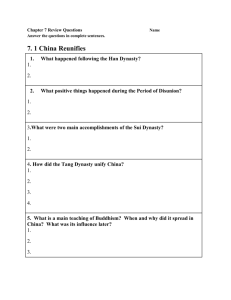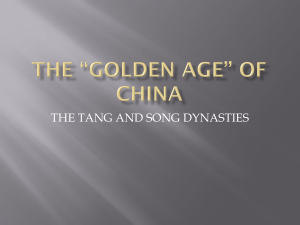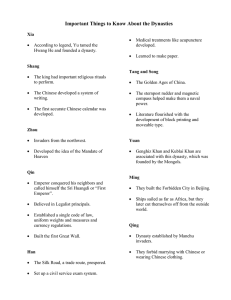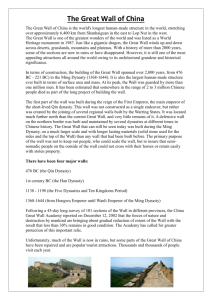Chinese Dynasties: Tang, Song, Yuan, Ming - History Overview
advertisement
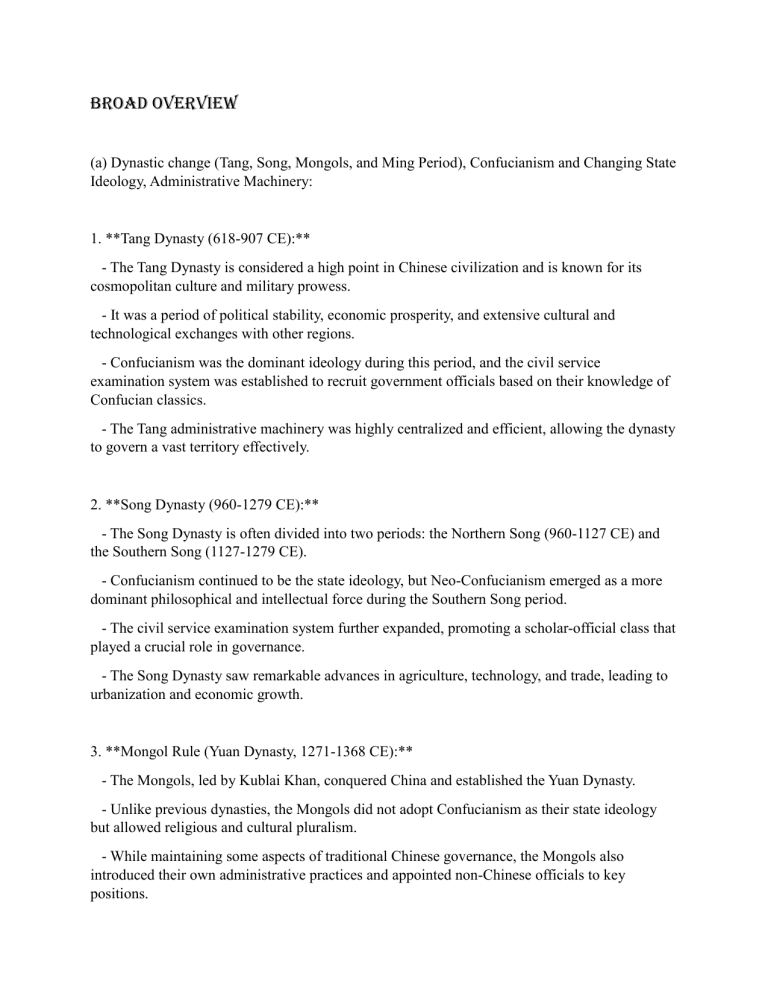
Broad Overview (a) Dynastic change (Tang, Song, Mongols, and Ming Period), Confucianism and Changing State Ideology, Administrative Machinery: 1. **Tang Dynasty (618-907 CE):** - The Tang Dynasty is considered a high point in Chinese civilization and is known for its cosmopolitan culture and military prowess. - It was a period of political stability, economic prosperity, and extensive cultural and technological exchanges with other regions. - Confucianism was the dominant ideology during this period, and the civil service examination system was established to recruit government officials based on their knowledge of Confucian classics. - The Tang administrative machinery was highly centralized and efficient, allowing the dynasty to govern a vast territory effectively. 2. **Song Dynasty (960-1279 CE):** - The Song Dynasty is often divided into two periods: the Northern Song (960-1127 CE) and the Southern Song (1127-1279 CE). - Confucianism continued to be the state ideology, but Neo-Confucianism emerged as a more dominant philosophical and intellectual force during the Southern Song period. - The civil service examination system further expanded, promoting a scholar-official class that played a crucial role in governance. - The Song Dynasty saw remarkable advances in agriculture, technology, and trade, leading to urbanization and economic growth. 3. **Mongol Rule (Yuan Dynasty, 1271-1368 CE):** - The Mongols, led by Kublai Khan, conquered China and established the Yuan Dynasty. - Unlike previous dynasties, the Mongols did not adopt Confucianism as their state ideology but allowed religious and cultural pluralism. - While maintaining some aspects of traditional Chinese governance, the Mongols also introduced their own administrative practices and appointed non-Chinese officials to key positions. 4. **Ming Dynasty (1368-1644 CE):** - The Ming Dynasty restored Han Chinese rule after overthrowing the Yuan Dynasty. - Confucianism regained its prominence as the state ideology, and the civil service examination system was reinvigorated. - The Ming period saw a strengthening of the centralized bureaucracy, with a focus on meritocracy in government appointments. - The Ming Dynasty is known for its maritime explorations, including Zheng He's famous voyages, which expanded China's influence and trade networks. (b) **Agriculture and Trade, Technological Growth, Cultural Efflorescence (Ming Period):** 1. **Agriculture and Trade:** - During the Ming period, agriculture remained the backbone of the Chinese economy, with rice as the primary staple crop, particularly in the south. - New agricultural techniques and innovations were introduced, leading to increased productivity and population growth. - Trade flourished, both within China and with other regions through the maritime Silk Road, as well as overland routes like the Silk Road. 2. **Technological Growth:** - The Ming Dynasty witnessed significant technological advancements. - The most prominent example is the publication of the "Encyclopedia of the Treasured Tool" (also known as the Yongle Encyclopedia) during the early 15th century, a comprehensive compilation of knowledge from various fields. 3. **Cultural Efflorescence:** - The Ming period was marked by a flourishing of arts, literature, and cultural achievements. - Chinese painting, calligraphy, and ceramics reached new heights during this time. - The Ming Dynasty also witnessed the development of vernacular literature, which made literary works more accessible to the common people. 1. **Tang Dynasty (618-907 CE)**: The Tang Dynasty is often regarded as a golden age in Chinese history. Under the Tang rule, China experienced a period of political stability, economic prosperity, and cultural flourishing. - **Confucianism and Changing State Ideology**: The Tang Dynasty adopted Confucianism as the state ideology, which emphasized the importance of moral values, social order, and filial piety. This ideology served as the foundation for the establishment of a well-organized and centralized bureaucratic system that recruited officials based on their knowledge of Confucian classics. The civil service examination system was expanded during this period, leading to the rise of a scholar-official class, which played a significant role in governance. The Tang Dynasty’s adoption of Confucianism as the state ideology was significant for the promotion of moral values and social order. According to the book “East Asia: The Great Tradition,” Confucian principles, such as the Five Relationships (Wu Lun) and the importance of filial piety, played a crucial role in shaping the social hierarchy and governance of the empire. Confucian classics, particularly the Four Books and Five Classics, were considered essential texts for aspiring officials in the civil service examination system. - **Administrative Machinery**: The Tang Dynasty's administrative machinery was highly centralized and efficient. It was organized into six major ministries, each responsible for specific government functions. The centralization of power allowed the Tang government to govern a vast territory effectively and maintain control over local officials. The book “Science and Civilization in China” by Joseph Needham highlights the Tang Dynasty’s administrative achievements. The dynasty established the Three Departments and Six Ministries system, which was a well-organized and efficient bureaucratic structure. The Three Departments consisted of the Chancellery, Imperial Secretariat, and Censorate, while the Six Ministries covered essential government functions like personnel, finance, rites, and justice. This wellstructured administrative machinery allowed the Tang Dynasty to govern its vast territory effectively and efficiently. **Technological Growth**: The Tang Dynasty witnessed remarkable technological advancements, including advancements in agricultural technology. In Joseph Needham’s “Science and Civilization in China,” he discusses the introduction of the horse collar and the widespread use of the iron plow, which increased agricultural productivity. Additionally, innovations such as the mechanical seed drill and water-powered mills further improved agricultural efficiency. **Cultural Exchange and International Relations**: The Tang Dynasty was a cosmopolitan period marked by extensive cultural exchange and international trade. The Silk Road, which connected China with Central Asia and beyond, facilitated the exchange of goods, ideas, and technologies. Foreign envoys and scholars visited the Tang court, contributing to the diffusion of knowledge and cultural diversity, as highlighted in “East Asia: The Great Tradition.” 2. **Song Dynasty (960-1279 CE)**: The Song Dynasty can be divided into two periods: the Northern Song (960-1127 CE) and the Southern Song (1127-1279 CE). The Song Dynasty is known for its achievements in science, art, and governance. - **Confucianism and Changing State Ideology**: Confucianism continued to be the dominant state ideology during the Song Dynasty. However, as Neo-Confucianism emerged as a more dominant philosophical and intellectual force, there was an emphasis on metaphysical and ethical questions. Neo-Confucian scholars sought to integrate Confucianism with Taoism and Buddhism, leading to a more holistic worldview. The Song Dynasty’s reliance on Confucianism continued, but a significant development during this period was the rise of Neo-Confucianism, which emphasized metaphysical and ethical questions. In “East Asia: The Great Tradition,” it is noted that Neo-Confucian scholars, such as Zhu Xi, sought to harmonize Confucianism with Daoism and Buddhism, creating a more comprehensive philosophical system that addressed not only social governance but also the individual’s moral cultivation. - **Administrative Machinery**: The Song Dynasty further developed and expanded the civil service examination system, placing more emphasis on the meritocracy in government appointments. This system allowed talented individuals from different social backgrounds to rise through the ranks based on their knowledge and abilities. Despite this emphasis on merit, corruption and factionalism remained challenges in the Song bureaucracy. During the Song Dynasty, the civil service examination system expanded, and more emphasis was placed on selecting officials based on merit rather than their family background. According to the “History of Humanity Volume IV,” this led to a more educated and capable scholar-official class, but it also brought challenges like examination fraud and regional factionalism. Despite these issues, the system remained a significant means of social mobility and continued to play a vital role in government appointments. **Agricultural and Economic Growth**: The Song Dynasty experienced significant economic growth, which was partly driven by advancements in agriculture. Innovations such as fastripening rice varieties, as mentioned in Joseph Needham’s work, contributed to increased agricultural output. This surplus production supported urbanization and a flourishing market economy, with thriving trade networks both within China and overseas. **Technological Achievements**: The Song Dynasty is renowned for its technological achievements, as documented in “Science and Civilization in China.” Notable inventions during this period included printing technology, gunpowder, compasses, and various mechanical devices. These technological breakthroughs had a profound impact on Chinese society and had far-reaching effects globally. 3. **Mongol Rule (Yuan Dynasty, 1271-1368 CE)**: The Yuan Dynasty was established by the Mongols, led by Kublai Khan, after they conquered China. It was the first time a non-Han ethnic group ruled over the Chinese empire. - **Changing State Ideology**: Unlike previous Chinese dynasties, the Mongols did not adopt Confucianism as their state ideology. Instead, they practiced religious and cultural pluralism, allowing various beliefs and customs to coexist. While Confucianism continued to be influential, it was no longer the sole guiding principle of the state. The Yuan Dynasty’s ruling Mongols practiced a different state ideology than the previous Chinese dynasties. In “Science and Civilization in China,” Joseph Needham notes that while the Mongols allowed religious freedom and tolerated various beliefs, they also adopted some aspects of Chinese culture and governance. The Yuan rulers supported Buddhism and Daoism, but they did not promote Confucianism as the exclusive ideology. - **Administrative Machinery**: The Yuan Dynasty retained some elements of the traditional Chinese administrative system but also introduced Mongol administrative practices. The highest positions in the bureaucracy were often filled by Mongols or other non-Chinese officials. This led to tensions and conflicts between the ruling Mongols and the Han Chinese population. The “History of Humanity Volume IV” highlights that the Yuan Dynasty employed a dual administrative structure, with separate systems for governing Mongol and Chinese affairs. The highest positions in the government were often held by Mongols or non-Chinese officials, which sometimes led to tensions and conflicts with the Han Chinese population. Despite this, the mongol rule facilitated cultural exchanges and trade connections between China and the other regions under their control. **Maritime Expeditions**: The Yuan Dynasty facilitated maritime expeditions, as described in “East Asia: The Great Tradition.” The famous explorer Zheng He led seven epic voyages that reached as far as East Africa, promoting Chinese influence and trade across the Indian Ocean. These expeditions were a testament to the Yuan Dynasty’s maritime ambitions. **Religious and Cultural Pluralism**: Under Mongol rule, the Yuan Dynasty exhibited a degree of religious and cultural tolerance, allowing various beliefs to coexist. This tolerance extended to Buddhism, Daoism, and Christianity, among others. While Mongol rulers followed their traditional shamanistic beliefs, they respected the religious practices of their subjects. 4. **Ming Dynasty (1368-1644 CE)**: The Ming Dynasty was founded by the ethnic Han Chinese after they successfully overthrew the Yuan Dynasty. It is known for its emphasis on cultural restoration and maritime exploration. - **Confucianism and Changing State Ideology**: The Ming Dynasty restored Confucianism as the state ideology and emphasized the importance of traditional Chinese culture. The civil service examination system was reestablished, and Confucian classics became the basis for selecting and training government officials. The Ming Dynasty sought to restore Confucianism as the state ideology and promote traditional Chinese culture. According to the book “East Asia: The Great Tradition,” this emphasis on Confucian teachings reinforced social hierarchy and the importance of maintaining harmony in society. The Ming rulers encouraged the study of Confucian classics and implemented policies to preserve and promote Chinese cultural heritage. - **Administrative Machinery**: The Ming Dynasty strengthened the centralized bureaucracy, aiming to reduce the power of local officials and ensure loyalty to the central government. There were also efforts to curtail the influence of eunuchs in the imperial court, who had gained significant power during the Yuan Dynasty. The “Science and Civilization in China” by Joseph Needham highlights the Ming Dynasty’s efforts to strengthen the centralized bureaucracy. The Hongwu Emperor, the founding ruler of the Ming Dynasty, attempted to reduce the power of local officials and centralize authority in the imperial court. However, corruption and inefficiency continued to be challenges in the administrative system. **Maritime Exploration and the Treasure Fleet**: The Ming Dynasty continued to invest in maritime exploration and trade, as highlighted in Joseph Needham’s work. The Ming treasure fleets, led by Admiral Zheng He, undertook voyages of exploration and diplomacy. These voyages aimed to establish China’s influence, promote trade, and showcase the Ming Dynasty’s wealth and power. **Cultural Efflorescence**: The Ming Dynasty is considered a time of cultural efflorescence, with significant contributions to arts and literature. Ming painters and calligraphers, such as Shen Zhou and Dong Qichang, emerged as prominent figures in the art world. In literature, the Ming saw the publication of renowned literary works, including novels like “Romance of the Three Kingdoms” and “Journey to the West.” In conclusion, the dynastic changes in medieval China brought about significant shifts in state ideology and administrative machinery. From the Tang Dynasty's Confucian-centered governance to the Song Dynasty's emphasis on Neo-Confucianism and meritocracy, each dynasty left a profound impact on Chinese history. The Mongol rule introduced new cultural influences, while the Ming Dynasty reestablished Confucianism and emphasized maritime exploration and cultural restoration. Understanding these historical developments is crucial for comprehending the complexities and continuities in Chinese civilization. IMPORTANT RULERS AND THEIR MAJOR CONTRIBUTIONS Certainly! Let’s delve deeper into the important rulers and their major contributions during each dynasty: 1. **Tang Dynasty (618-907 CE)**: - **Emperor Taizong (r. 626-649 CE)**: Emperor Taizong, also known as Li Shimin, was one of the greatest emperors in Chinese history. He played a key role in founding the Tang Dynasty and was an accomplished military strategist and administrator. His reign was marked by territorial expansion, consolidating and strengthening the Tang Empire. - **Empress Wu Zetian (r. 690-705 CE)**: Empress Wu Zetian was the only female ruler in Chinese history to hold the title of Emperor. After the death of her husband, Emperor Gaozong, she effectively ruled the Tang Dynasty through her sons and became the reigning monarch in her own right. Her reign saw advancements in governance and a patronage of the arts and literature. 2. **Song Dynasty (960-1279 CE)**: - **Emperor Taizu (r. 960-976 CE)**: Emperor Taizu, also known as Zhao Kuangyin, was the founding emperor of the Song Dynasty. He was a skilled military general who reunified China after the fall of the Tang Dynasty. Under his rule, the Northern Song period began, characterized by significant economic growth and cultural achievements. - **Emperor Huizong (r. 1100-1125 CE)**: Emperor Huizong was a patron of arts and culture during the Northern Song period. He was a talented painter and calligrapher himself, and his court was a center of artistic excellence. However, his reign also faced military defeats, leading to the eventual downfall of the Northern Song Dynasty. 3. **Mongol Rule (Yuan Dynasty, 1271-1368 CE)**: - **Kublai Khan (r. 1260-1294 CE)**: Kublai Khan, the grandson of Genghis Khan, was the founder of the Yuan Dynasty and the first non-Han ruler to govern China. He successfully unified China under Mongol rule, becoming the Great Khan of the Mongol Empire and the Emperor of China. Kublai Khan encouraged cultural exchange, supported the arts, and sought to incorporate Chinese traditions into Mongol governance. 4. **Ming Dynasty (1368-1644 CE)**: - **Emperor Hongwu (r. 1368-1398 CE)**: Emperor Hongwu, whose given name was Zhu Yuanzhang, was the founder of the Ming Dynasty. He rose from humble beginnings as a Buddhist monk to become a military leader who successfully overthrew the Yuan Dynasty. He implemented significant reforms, including land redistribution and the establishment of the civil service examination system. - **Zheng He (1371-1433 CE)**: Zheng He, a eunuch and explorer, played a crucial role during the early Ming Dynasty. He led several maritime expeditions known as the Treasure Voyages, which aimed to showcase China’s power, establish diplomatic relations, and promote trade with other regions. These voyages reached as far as Southeast Asia, India, the Persian Gulf, and East Africa. The reigns of these notable rulers in each dynasty had a profound impact on Chinese history and shaped the political, cultural, and economic landscape of their respective eras. Their contributions ranged from military conquests and territorial expansion to advancements in governance, cultural patronage, and exploration. Understanding the key figures and their achievements provides a more nuanced understanding of medieval China’s historical development and the legacies they left behind. MORE INFORMATION 1. **Tang Dynasty (618-907 CE)**: - **Emperor Xuanzong (r. 712-756 CE)**: Emperor Xuanzong, also known as Li Longji, ruled during the peak of the Tang Dynasty. His reign is often considered a cultural high point, known as the "Great Prosperity of the Kaiyuan Era.” He was a patron of arts and literature, supporting renowned poets like Li Bai and Du Fu, contributing to the flourishing of Tang poetry. - **Empress Wu Zetian (r. 690-705 CE)**: As an additional point, Empress Wu Zetian deserves further attention for her remarkable rise to power and influence. After seizing power, she established the Zhou Dynasty, which was a brief interlude between the Tang Dynastic periods. Empress Wu was an advocate for gender equality and appointed capable officials based on their abilities rather than their social status. 2. **Song Dynasty (960-1279 CE)**: - **Emperor Renzong (r. 1022-1063 CE)**: Emperor Renzong was an exemplary ruler during the Northern Song period. He promoted Confucianism as the state ideology and invested in education, encouraging scholarship and the study of classics. His reign was marked by stability, economic growth, and cultural prosperity. - **Emperor Huizong (r. 1100-1125 CE)**: In addition to being a significant patron of arts and culture, Emperor Huizong was also a scholar with a deep interest in various disciplines, including calligraphy, painting, and music. He compiled and sponsored important historical and literary works, contributing to the preservation of Chinese cultural heritage. 3. **Mongol Rule (Yuan Dynasty, 1271-1368 CE)**: - **Khubilai Khan (r. 1271-1294 CE)**: Khubilai Khan, or Emperor Shizu, was one of the most influential rulers of the Yuan Dynasty. Under his rule, the Mongol Empire reached its peak, encompassing China, Mongolia, Central Asia, and parts of the Middle East. He promoted cultural exchange between different ethnic groups and religions within the empire. - **Giovanni da Montecorvino (1247-1328 CE)**: As an additional point, it is essential to mention the Italian Franciscan missionary, Giovanni da Montecorvino, who arrived in China during the Yuan Dynasty. He played a significant role in spreading Christianity and established churches and missions in various parts of China, particularly in the south. 5. **Ming Dynasty (1368-1644 CE)**: - **Emperor Yongle (r. 1402-1424 CE)**: Emperor Yongle, also known as Zhu Di, was a crucial figure in the Ming Dynasty. He moved the capital from Nanjing to Beijing and commissioned the construction of the Forbidden City, which became the imperial palace for successive Ming and Qing emperors. He was also responsible for overseeing the compilation of the Yongle Encyclopedia, an extensive collection of Chinese knowledge. - **Wang Yangming (1472-1529 CE)**: As an additional point, Wang Yangming was a prominent Neo-Confucian philosopher during the Ming Dynasty. His ideas and teachings emphasized the importance of self-cultivation and moral integrity. He argued for the unity of knowledge and action, advocating that individuals must act in accordance with their innate moral understanding, which became influential in later Chinese philosophy. Confucius (Kung Fu-tzu): Confucius, also known as Kung Fu-tzu, lived from approximately 551-479 BCE. He was born in the state of Lu, which is present-day Shandong province, China. Confucius belonged to a lower class of pour aristocracy and had a deep understanding of traditional knowledge. • Development of Confucianism: Confucius teachings and the development of Confucianism gained prominence during the 5th century BCE. His philosophical ideas, moral principles, and social teachings became influential during this time and continued to shape Chinese thought and beliefs for centuries to come. • Mencius (Meng-tzu): Mencius, one of the most prominent followers of Confucianism, lived during the 4th century BCE. He expanded upon Confucius’ teachings, emphasizing the inherent goodness of human nature and the importance of cultivating virtuous leadership. Mencius advocated for a government that prioritized the welfare of its people and criticized corrupt rulers. • Hsun-tzu: Hsun-tzu, another philosopher influenced by Confucianism, lived during the 3rd Century BCE. While he agreed with Confucian values, Hsun-tzu had a different perspective on Human nature. He believed that human nature was inherently evil, but it could be improved Through proper education, discipline, and adherence to rituals. Hsun-tzu emphasized Hierarchical social order and strict adherence to rituals for social harmony. CHANGING STATE IDEOLOGY:- ⚫ Chinese state ideology was influenced by conventional traditions and ruling dynasties, drawing from Confucianism, Taoism, and Buddhism. Wang An-shih led a reform movement in the 11th century (1021-1086 CE) that aimed to alleviate the Suffering of the masses. His proposals included public schools, revised civil service exams, relief for Peasants, fair taxation, and land redistribution. Wang’s ideas contained elements of state socialism and were met with resistance from conservative Factions. Chu-His, associated with the Song Court in the 12th century (1130-1200 CE), founded the NeoConfucian school of thought, incorporating Taoist and Buddhist elements. His teachings emphasized the concept of the “Supreme Ultimate” and promoted a paternalistic state administered by Scholar-officials. • Chu-His’s Neo-Confucianism became influential, integrated into examination curricula and serving as the foundation of Chinese state ideology ADMINISTRATIVE MACHINERY: • Tang administrative structure (618-907): Centralized with the emperor in control, resembling the Han system. Divided into provinces, prefectures, and sub-prefectures. Imperial civil-service exams were held To select officials based on merit. • Tang social structure: Peasant proprietorship, with tenants and a small proportion of slaves. Unequal Wealth distribution. Tang rulers supported a graded nobility not solely based on land ownership. •Separation of power: Tang Dynasty maintained a separation between civil and military authority. Tang emperors didn’t exercise absolute military power, but warlords gained political influence as the dynasty weakened. • Ming bureaucracy (1368-1644): Became rigid, with officials chosen from exam candidates. Surplus of successful candidates and shortage of positions. Emphasis on literary forms and ideological orthodoxy, leading to a scholar-gentry class considering themselves superior. • Challenges and corruption: Tang administration faced corruption, lazy officials, heavy taxation on Peasants, increased military expenditure, loss of frontiers, and internal dissensions. Ming bureaucracy Became inefficient and prone to corruption due to overemphasis on degrees and lack of practical Administrative aptitude.
